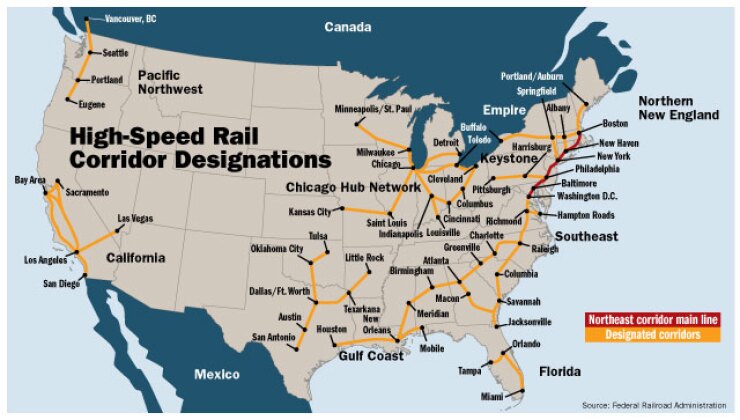

WASHINGTON — The development of a 17,000-mile national high-speed rail network would cost $600 billion, or $30 billion per year through 2030, Andy Kunz, president and chief executive officer of the U. S. High Speed Rail Association, said here at a conference yesterday.
Kunz’s estimate seems to put into context — and illustrate the meagerness of — the $8 billion that Congress provided for high-speed rail in the American Recovery and Reinvestment Act enacted in February.
The $8 billion is “not going to go very far, and we know that,” Rep. Eddie Bernice Johnson, D-Tex., said during the conference, which the association sponsored to promote the development of high-speed rail corridors designated by the Federal Railroad Administration and the linking of them into a national network.
Several members of Congress and Pennsylvania Gov. Edward G. Rendell, who also spoke at the conference, called for varying levels of funding and methods of paying for high-speed rail.
Rep. Ciro Rodriguez, D-Tex., said that federal contributions of $5 billion or more per year for 10 years — or at least $50 billion total — would be necessary to build a national network.
Rendell called for the creation of a national infrastructure bank that would finance rail corridors, in addition to other infrastructure projects.
Though the $8 billion provided so far seems small compared to Kunz’s $600 billion estimate, momentum in Congress has been growing for high-speed rail funding. A House subcommittee hearing last week drew a standing-room only crowd.
A multi-year transportation bill pending in the House Transportation Committee would provide up to 80% of high-speed rail corridor planning costs, as long as at least 20% of the funding came from state or local coffers. It would allow public-private partnerships to fund high-speed rail projects. It also would require the transportation secretary to create a high-speed rail corridor development program and to provide competitive grants to projects aligned with that program.
The U.S. High Speed Rail Association was formed in July “to help advance [President Obama’s] visionary plan” for high-speed rail. In a press release announcing its formation, the group called for a “state-of-the-art dedicated track, advanced control systems, elegant multi-modal train stations, and top-of-the-line 220 mph trains.”
Its board includes Norman F. Anderson, president and chief executive officer of CG/LA Infrastructure LLC; Katherine Aguilar Perez, executive director of the Urban Land Institute, Los Angeles District Council; and Anthony Perl, urban studies program director at Simon Fraser University in Vancouver.





